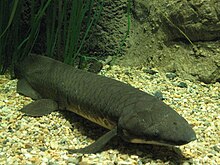
Back سمك رئوي كوينزلاندي Arabic سمك رئوى كوينزلاندى ARZ Рагазуб Byelorussian Неоцератодус Bulgarian Neoceratodus forsteri CEB Bahník australský Czech Australischer Lungenfisch German Aŭstralia pulmofiŝo Esperanto Neoceratodus forsteri Spanish Neoceratodus forsteri Basque
| Australian lungfish | |
|---|---|

| |
| National Zoo & Aquarium, Australia | |
| Scientific classification | |
| Domain: | Eukaryota |
| Kingdom: | Animalia |
| Phylum: | Chordata |
| Clade: | Sarcopterygii |
| Class: | Dipnoi |
| Order: | Ceratodontiformes |
| Family: | Neoceratodontidae |
| Genus: | Neoceratodus |
| Species: | N. forsteri
|
| Binomial name | |
| Neoceratodus forsteri (J. L. G. Krefft, 1870)
| |

| |
| Synonyms[4][5][6] | |
| |
The Australian lungfish (Neoceratodus forsteri), also known as the Queensland lungfish, Burnett salmon and barramunda, is the only surviving member of the family Neoceratodontidae. It is one of only six extant lungfish species in the world. Endemic to Australia,[7] the Neoceratodontidae are an ancient family belonging to the class Sarcopterygii, or lobe-finned fishes.[8]
Fossil records of this group date back 380 million years, around the time when the higher vertebrate classes were beginning to evolve.[9] Fossils of lungfish almost identical to this species have been uncovered in northern New South Wales, indicating that Neoceratodus has remained virtually unchanged for well over 100 million years, making it a living fossil and one of the oldest living vertebrate genera on the planet.[9]
It is one of six extant representatives of the ancient air-breathing Dipnoi (lungfishes) that flourished during the Devonian period (about 413–365 million years ago) and is the outgroup to all other members of this lineage.[9][10] The five other freshwater lungfish species, four in Africa and one in South America, are very different morphologically from N. forsteri.[9] The Queensland lungfish can live for several days out of the water, if it is kept moist, but will not survive total water depletion, unlike its African counterparts.[7]
The small settlement of Ceratodus in the Wide Bay–Burnett region of Queensland derives its name from that of the Australian lungfish. The species was named, by Gerard Krefft, in honour of the squatter and politician William Forster.[11]
- ^ "Neoceratodus forsteri Krefft 1870". PBDB.
- ^ Brooks, S., Espinoza, T., Kennard, M., Arthington, A. & Roberts, D. (2019). "Neoceratodus forsteri". IUCN Red List of Threatened Species. 2019: e.T122899816A123382021. doi:10.2305/IUCN.UK.2019-3.RLTS.T122899816A123382021.en. Retrieved 25 March 2022.
{{cite journal}}: CS1 maint: multiple names: authors list (link) - ^ "Appendices | CITES". cites.org. Retrieved 14 January 2022.
- ^ "Part 7- Vertebrates". Collection of genus-group names in a systematic arrangement. Archived from the original on 5 October 2016. Retrieved 30 June 2016.
- ^ Haaramo, Mikko (2007). "Ceratodiformes – recent lungfishes". Mikko's Phylogeny Archive. Retrieved 3 July 2016.
- ^ Froese, R.; Pauly, D. (2017). "Neoceratodontidae". FishBase version (02/2017). Retrieved 18 May 2017.
- ^ a b Lake, John S. Australian Freshwater Fishes. Nelson Field Guides. Melbourne: Thomas Nelson Australia Pty. Ltd., 1978. p. 12.
- ^ "Catalog of Fishes Classification". Catalog of Fishes, calacademy.org. California Academy of Sciences. January 2017. Retrieved 4 March 2017.
- ^ a b c d Allen, G.R., S.H. Midgley, M. Allen. Field Guide to the Freshwater Fishes of Australia. Eds. Jan Knight, Wendy Bulgin. Perth, W.A.: Western Australia Museum, 2002. pp. 54–55.
{{cite book}}: CS1 maint: multiple names: authors list (link) - ^ Frentiu, F.D., J.R. Ovenden, and R. Street (2001). "Australian lungfish (Neoceratodus forsteri: Dipnoi) have low genetic variation at allozyme and mitochondrial DNA loci: a conservation alert?". Conservation Genetics. 2: 63–67. doi:10.1023/A:1011576116472. S2CID 22778872.
{{cite journal}}: CS1 maint: multiple names: authors list (link) - ^ "THE NATURALIST". The Queenslander. Vol. XXVI, no. 470. Queensland, Australia. 27 September 1884. p. 507. Retrieved 19 October 2018 – via National Library of Australia.
© MMXXIII Rich X Search. We shall prevail. All rights reserved. Rich X Search
